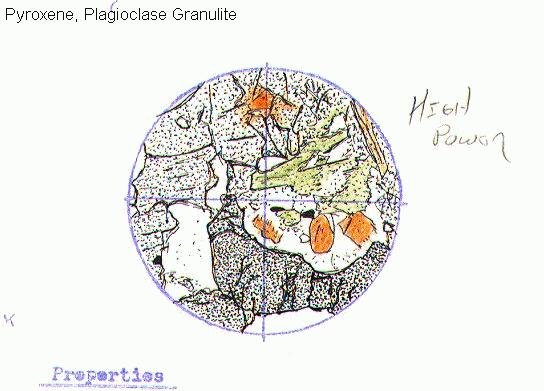Pyroxene Plagioclase Granulite

High power view of a sample transitional from the previous quartz feldspar gneiss. This sample shows "granulitic" texture characteristic of small, equi-dimintional grains, typical 120 degree grain boundaries, and lack of gneissic, or banded texture. The mineralogy of the sample includes virtually no quartz and the feldspar is entirely plagioclase "anorthite". Small amounts of hornblend and biotite remain, and the biotite still shows dis-equilibrium with the garnet where the two typically try to make contact. They share the same ionic needs but garnet is the stable mioneral at these conditions. Granulite is the highest grade of metamorphic rock attainable. After this the conditions become so extreme that the rock begins to partially or fully melt, a whole new ballgame. Pyroxene in the form of hypersthene become the dominant mineral species as it has a compact and dry crystal structure.
Metamorphic rock naming convention: first minor or accessory minerals, second main rock-forming minerals, thirdly rock texture, (geniss or granulite in my case).
My Master's Thesis consisted of mapping, collecting, studying, and analysing numerous rock types from a small area of Southwest Montana. The analysis revealed the area to be an ancient terrain formed originally as sediments deposited in an open marien shelf setting prior to 2.8 billion years ago. By 2.8 Billion Years ago the section had already been very deeply buried in an active tectonic zone. The original sediments, under extreme conditions of temperature and pressure, were folded and changed, the crystals growing new minerals stable under the conditions, and resetting geolgic clock to that event. The section has largely remained stable from that time until recent. At about 1.6 Billion years the region was uplifted and the unroofing caused some retrograde mineral changes and certain areas adjusted to conditions lf lower temperature and pressure. In my thesis area the mineralogy largly escaped this event, probably due to the extreme dryness of the minerology. Ions simply were unable to migrate and reform new minerals.
My study was to document these ancient events and to determine, via study of the minerology, the conditions of temperature and pressure under which these minerals originally formed and to find evidence, if possible, of the original sedimentary nature of the section.
kjs
For those interested in the bitter detail on the petrology and origin of Gneiss and associated rocks, at least from one specific ancient locality, see my
Master's Thesis....
Go back....

